OpenMarket – January 9, 2020
Every brand wants to know which channel they should use for customer communications – in which situations.
We’ve got some research findings to help with that. Our Empathy in the Age of AI strategy guide delivers insights from a survey of more than 4,000 consumers and 600 CX experts.
It underlines the popularity of mobile messaging, with stats such as these:
•74% of consumers say the mobile inbox is their primary communication method for getting things done
•67% say they find it less stressful to deal with brands via messaging than by phone. And 60% find it less stressful than email.
CX leaders rank the benefits of mobile messaging as:
1. Easy to use and convenient
2. Low cost
3. Opportunity for two-way conversation with customers
4. Conversational nature that customers like
5. Opportunity to deliver personal interactions at scale
The Empathy in the Age of AI strategy guide also sets out which messaging platforms consumers like to use in different circumstances.
Take a look at this table.


 The findings suggest many consumers don’t feel that OTT messaging apps (like WhatsApp or Facebook Messenger) are ideal channels to interact with brands on.
The findings suggest many consumers don’t feel that OTT messaging apps (like WhatsApp or Facebook Messenger) are ideal channels to interact with brands on.
The traditional messaging inbox – which receives SMS, MMS, RCS and Apple iMessage – is the clear winner. The research goes on to suggest that the fact these channels require no app downloads is a big draw.
(That’s why Apple, with its Apple Business Chat offering, and Google, with its business version of RCS Chat, are working so hard to help businesses communicate with customers.
But bear in mind that OTT messaging apps haven’t been business channels for long. Consumers’ appetite for using them to communicate with brands could develop fast.
A multi-channel future
We are entering an era in which brands use different mobile messaging and OTT channels for different customers – depending on those customers’ preferences and the situation in question.
It’s worth noting that the research reveals a big appetite for a richer type of messaging – something more than the text-only experience SMS has offered for so long.
Nearly three-quarters (73%) of consumers say engaging, interactive communications are important.
And nearly two-thirds (63%) say they are likely to interact with businesses via mobile messaging when communications feature images, videos and app-like interactivity.
Your focus should be on setting up an ecosystem in which a variety of mobile messaging types can seamlessly operate together – and alongside other channels.
Our Empathy in the Age of AI strategy guide sets out how you can do just that. The guide also offers up more insights about the channels consumers favor.
Of course there are other pieces to the customer experience and communication puzzle – from personalization to AI, sentiment analysis and natural language processing.
Then there’s the skill of integrating all these technologies.
To learn how to do all this, and for a plethora of CX findings and analysis, download our Empathy in the Age of AI strategy guide.


